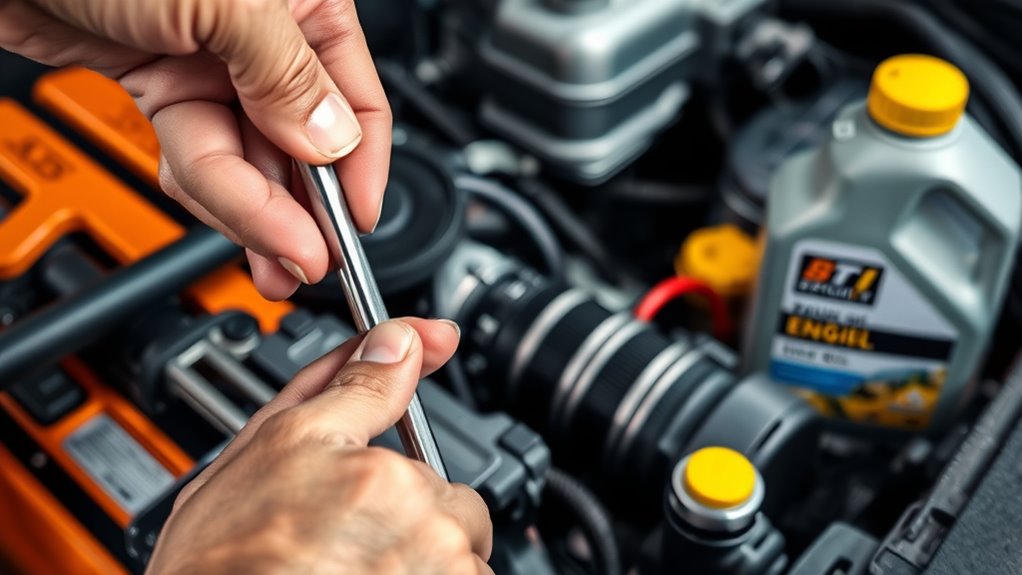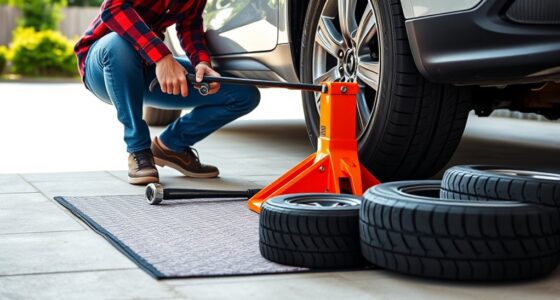To check and top up your engine oil, start with the engine cool and locate the dipstick, usually with a bright handle. Remove it, wipe clean, then reinsert fully before pulling it out again to check the level between the “low” and “full” marks. If the oil is low, add small amounts of the recommended oil, checking the level frequently. Keep your engine healthy by following proper procedures—continue for more useful tips.
Key Takeaways
- Start with a cool engine, locate the dipstick, remove, wipe clean, then reinsert fully for an accurate oil level check.
- Pull out the dipstick again and ensure the oil level is between the “low” and “full” marks.
- Use the recommended oil type and viscosity for your vehicle when topping up.
- Add oil slowly through the fill cap, checking the level frequently to avoid overfilling.
- Wait a minute after adding, then recheck the level to ensure it’s within the optimal range.

Checking and topping up your engine oil is a simple but vital maintenance task that helps keep your vehicle running smoothly. Regularly inspecting your oil level ensures your engine operates efficiently and reduces the risk of damage. To do this effectively, you’ll need to understand the importance of oil viscosity and adhere to recommended oil change intervals. Oil viscosity refers to the thickness of the oil and its ability to flow at various temperatures. Using the right viscosity, as specified in your vehicle’s owner’s manual, ensures ideal lubrication and protection for your engine parts. If you use oil that’s too thick or too thin, it can lead to increased engine wear or reduced performance. Over time, oil breaks down or becomes contaminated, which is why sticking to proper oil change intervals is essential. These intervals, typically every 5,000 to 7,500 miles or as recommended, help maintain the right oil quality, ensuring your engine stays well-lubricated and clean.
To check your engine oil level, start with a cool engine to get an accurate reading. Open the hood and locate the dipstick—usually marked with a bright handle. Pull it out, wipe it clean with a rag or paper towel to remove any oil residue, and then reinsert it fully. Pull it out again and examine the oil level. The dipstick will have markings indicating “low” and “full” levels. Your goal is to keep the oil between these marks. If the oil level is below the minimum mark, it’s time to top up. Remember, always use the oil viscosity recommended by your vehicle manufacturer; using the wrong type can affect engine performance and longevity. Additionally, choosing a high-quality oil with proper color accuracy can improve your engine’s overall operation and longevity.
When topping up, pour the oil slowly into the engine through the oil fill cap. It’s better to add a little at a time and check the level frequently to avoid overfilling. Overfilling can cause excessive pressure and leaks, so precision is key. After adding oil, wait a minute for it to settle, then recheck the level with your dipstick. Make sure the oil is within the recommended range. If your vehicle has high mileage or if you notice oil consumption between changes, more frequent checks and top-ups might be necessary. Staying on top of oil levels not only preserves engine health but also improves fuel efficiency and reduces emissions.
Frequently Asked Questions
How Often Should I Check My Engine Oil?
You should check your engine oil at least once a month or every 1,000 miles, whichever comes first. Regular checks help you monitor oil viscosity and detect any abnormal oil consumption early. If the oil level drops below the recommended mark or the oil appears dirty, top it up promptly. Keeping an eye on oil levels guarantees your engine runs smoothly and prevents potential damage caused by low or old oil.
Can I Use Synthetic Oil Instead of Regular Oil?
Yes, you can use synthetic oil instead of regular oil. Synthetic advantages include better engine protection, improved fuel efficiency, and longer-lasting performance. Just guarantee oil compatibility with your vehicle’s manufacturer recommendations. Synthetic oils work well with most engines, but double-check your owner’s manual to confirm it’s suitable. Switching to synthetic can be a smart choice for enhanced engine longevity and smoother operation, especially if you’re looking for better overall performance.
What Happens if I Overfill the Engine Oil?
Overfilling your engine oil is like pouring too much fuel into a fire—it can cause damage. When you add excess oil, it increases the oil viscosity, creating excessive pressure that may lead to engine leaks or seal damage. This can result in poor performance or costly repairs. Always check your oil level carefully and stick to the recommended amount to keep your engine running smoothly and avoid these risks.
Is It Necessary to Change the Oil Filter Regularly?
Yes, you should change the oil filter regularly to guarantee peak engine performance. Regular oil filter maintenance helps remove dirt, debris, and contaminants that accumulate over time, preventing engine damage. Typically, you’ll need to replace the oil filter every time you change the engine oil, usually every 3,000 to 5,000 miles or as recommended by your vehicle’s manufacturer. Proper oil filter replacement keeps your engine running smoothly and efficiently.
How Do I Know if My Engine Oil Is Contaminated?
Oil contamination feels like a silent enemy, hiding beneath the surface. You’ll notice signs of contamination such as a milky appearance, a burnt smell, or sludge buildup on the dipstick. Dark, gritty oil and unusual engine noises also signal trouble. To be sure, check your oil regularly—look for discoloration or debris. Catching these signs early helps prevent engine damage, keeping your vehicle running smoothly.
Conclusion
Keeping an eye on your engine oil is like tending to a delicate garden; neglect it, and everything suffers. By checking the level regularly and topping up when needed, you guarantee your engine runs smoothly and lasts longer. Think of it as watering a plant—small, consistent care prevents big problems down the road. So, make it a habit. After all, a well-maintained engine is the heartbeat of your vehicle’s journey.









